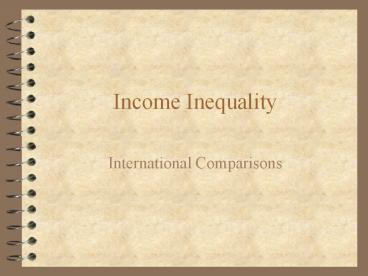Income Inequality - PowerPoint PPT Presentation
Title:
Income Inequality
Description:
Income Inequality International Comparisons Data Sources Luxembourg Income Study -- uses survey income from 25 countries; data organized to maximize comparability ... – PowerPoint PPT presentation
Number of Views:124
Avg rating:3.0/5.0
Title: Income Inequality
1
Income Inequality
- International Comparisons
2
Data Sources
- Luxembourg Income Study -- uses survey income
from 25 countries data organized to maximize
comparability measures equivalent disposable
income - World Development Indicators -- uses individual
country data some data is income data some data
is consumption data measures per capita income
or expenditure.
3
General Problems
- Debate over use of consumption vs income as
measure of economic well being - Income data generally excludes capital gains,
imputed rents, home production and most of income
in-kind. LIS survey does include near cash
benefits. Problems arise in making comparisons
across countries because one country may give out
cash to poor families while another relies more
on in-kind transfers.
4
Problems, cont.
- No account taken of indirect taxes of the
benefits of public spending - Snapshot at a single point in time so no measure
of mobility - Homeless population is typically not counted.
5
More Summary Measures
- Mean Logarithmic Deviation of Income
- Average of log ratios of the income of each
individual to mean income - Sensitive to changes at lower tail of
distribution - The Squared Coefficient of Variation
- Sum of squared deviations of income of each
individual from population mean, divided by mean
income - Sensitive to changes at upper tail of distribution
6
The Atkinson Index
- Normative index, based on concept of equally
distributed equivalent income - Researchers can adjust weight given in different
tails of distribution by setting a level of
inequality aversion. The greater the inequality
aversion (higher e), the more sensitive is the
index to changes at the bottom tail.
7
Formulas
8
Issues
- Has the U.S. trend towards increasing inequality
been replicated in other countries? - How do differences in tax and transfer policy
affect to income inequality? - How does the level of economic development affect
income inequality?
9
1980s Increase in Inequality Is International
Phenomena
- Smeedings table three shows increase inequality
in market income in nearly all countries. (Italy
experienced small decline in Gini.) - In some countries,increase in market income
inequality offset by taxes and transfers such
that disposable income inequality did not
increase.
10
LIS Database - Http//www.lis.ceps.lu/ineq.htm
- Australia, 1989-94
- Canada, 1991-94, no change
- Finland, 1987-95,
- France, 1984-94, -
- Germany, 1989-94,
- Hungary, 1991-94,
- Italy, 1991-96,
- Norway, 1991-95
- Poland, 1992-95
- Republic of China,1991-95
- Sweden, 1992-95, -
- United Kingdom, 1991-95
- United States, 1991-97
11
Taxes and Transfers Reduced Inequality
- Disposable income more equally distributed than
market income - Table 4 from Oxley, et al, Income Distribution
and Poverty in 13 OECD Countries, OECD Economic
Studies, No. 29, 1997,p. 71. - Other countries tend to engage more actively in
redistribution - Comparison of pre and post distributions of
income in the United States
12
Impact of Taxes/Transfers in United States -- 1998
Source US Census Bureau, 1998
13
Taxes, Transfers and the Growth in Inequality
Source Gramlich et al, Growing Inequality in
the 1980s The Role of Federal Taxes and Cash
Transfers, in Uneven Tides Rising Inequality in
America, edited by Danziger and Gottschalk, 1993.
14
Changes Over the 1980s
- Cuts in marginal tax rates for highest brackets
relative to other brackets. - Increases in Social Security taxes
- Increase in federal excise tax rates, but real
receipts constant - AFDC and Unemployment did not keep pace with
inflation
15
Kuznets Revisited































